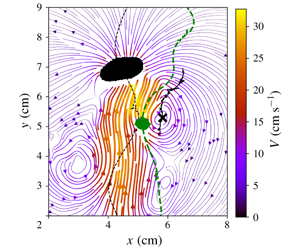Published online by Cambridge University Press: 06 February 2020

We present an exploratory study of the hydrodynamical interaction between two bubbles rising at high Reynolds numbers in a thin-gap cell. When they are isolated, the bubbles exhibit oscillatory motions and develop an unsteady wake with periodic release of vortices. Experiments combine bubble tracking and measurements of the liquid velocity field through volumetric time-resolved particle image velocimetry. This enabled us to analyse the kinematics of the bubbles during their interaction in relationship with the liquid flow field induced by their motion and governing their behaviour. We first investigate how the kinematics of a bubble, already submitted to the intrinsic instability of its path and wake, is modified by the interaction, i.e. by the presence of a liquid flow field generated by the companion bubble. Two main effects are highlighted in association with (i) the role of the ascending flow generated by the leading bubble, and of its spatial evolution, leading to a slowly varying vertical entrainment of the trailing bubble, and (ii) the role of the vortices released by the leading bubble inducing strong localized horizontal deviations on a bubble in line or in oblique positioning. In the latter case, two major scenarios are identified: deviations of the trailing bubble towards the wake centre line (centring in the wake) or away from it (ejection from the wake). We also show that a regular succession of ejections and re-alignments events may take place (cyclic alternation of ejections and centrings). The analysis is built on the knowledge of the behaviour of isolated bubbles, which is used as the basis for comparison to characterize the effect of the interaction, for the modelling of the vertical entrainment, and for the definition of a criteria on a dimensionless parameter characterizing the ability of a vortex to drive the bubble motion. In turn, we investigate the effect of a bubble passage in the liquid flow field generated by the companion bubble, highlighting the destruction or reinforcement of vortices. We show in particular that both effects can occur without a significant impact on the bubble kinematics.